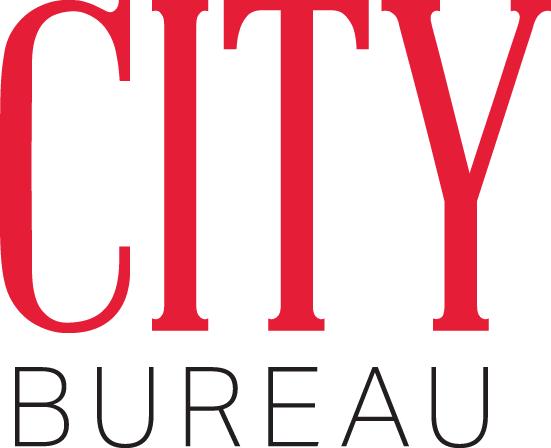Julia Hinojosa and Ebere Agwuncha of Arts+ Public Life reflect on the critical role their programs have in helping young people launch careers in the arts.’
By Jasmine Barnes
Young creators are featured in Out Loud: A Showcase of Youth Voice & Vision at Arts + Public Life in December 2024. (Provided/Joel Maisonet)
On a Monday evening in March, teenagers and their parents attended an open house at the Arts + Public Life Arts Block in Washington Park. Julia Hinojosa, the associate director of education programs, and Ebere Agwuncha, the education programs manager, welcomed parents to shadow their arts-curious teens, learn more about the group’s arts education program and connect with other community organizations.
An initiative of UChicago Arts at the University of Chicago, Arts + Public Life has been providing arts education for youth since 2011. As arts organizations continue to lose funding and extreme unemployment plagues young South and West Siders, the organization’s three paid job training programs offer teens on the South Side critical professional skills to learn what it’s like to have a job in the arts.
The Backstage Production Program explores the fundamentals of theater production, the Design Apprenticeship Program helps students design and build responsive, community-based projects in wood shop, and the Teen Arts Council focuses on arts administration, community engagement and event planning.
“Our charge is not to bring the arts to the South Side of Chicago, but instead to be a hub for the vibrant arts community that already exists here on the South Side,” Hinojosa said.
Hinojosa and Agwuncha spoke to City Bureau about the impact they’ve seen the arts education programs have on young people, including one of their current teaching artists who is an alumni of the program.
This interview has been edited and condensed for clarity.
How do arts education programs further your vision of creating sustainable South Side arts initiatives?
Julia Hinojosa, associate director of education programs at Arts + Public Life. (Provided/Anjali Pinto)
JH: [We] use the arts as a tool for youth development, allowing our young people to really understand who they are [within] our geographical community and how they can create something to have a positive impact . . . Our goal is for them to be able to see that they have agency, they have a voice [and we design our programs] in a way that is relevant and accessible for our young people.
EA: [Our programs are] bringing in a sustainable cycle where artists and makers in these communities are able to sustain the organizations and groups that exist, and they're able to make up their own spaces. They're able to have creative input in [local] organizations through the collaborations they have.
What impact does paying participants have on their commitment to the program?
Ebere Agwuncha, the education programs manager at Arts + Public Life. (Provided/Lyric Newbern)
EA: This is a job training program, so teens are expected to show up, participate, and be a present member within their programs. They are paid a stipend for the completion of their work in the program and I think it's really important to the teens . . . I think it gives the teens more accountability to themselves. If they don't show up for a day, they won't get paid for that day of class. It's an incentive to show up, be present, and work really hard in that program.
JH: We want to make sure that students understand that there is a value to their contributions when they're using their hands and their minds to create something new. There is value, not just in the emotional sense — the mindset — but also tangible, monetary, financial value to the work that they're doing, and it is okay for them to put a dollar amount to that. We really want them to understand that they are contributing significantly to the work that we're doing.
Do you have alumni who have completed your programs and are now pursuing a career in the arts?
JH : A lot of our students come back and serve on our staff in one way, shape or form. [Some] of our backstage production students have graduated, gone on to school, and now serve as production assistants for our live programs.
EA: Aisha Romer is someone that is an alumni of the [2018] Design Apprenticeship Program . . . They have gone on to complete a Bachelor of Arts Degree in Theater and Performance from the University of Illinois Chicago, and completed stage design and construction courses within that degree. They were hired this fall of 2024, as [an Arts + Public Life] co-instructor for the same program that they were in! It’s a full circle moment from student to teacher that really affirms the work we're doing.
What changes have you seen in the way young people approach these opportunities to prepare them for jobs?
JH: The idea of art being a sustainable and viable career path for young people is something that I have definitely seen change over the years. I think before, being part of an arts program was something fun to do for young people, but I often heard them say, “Well, I'm going to find myself a ‘real job’” . . . Now that is morphing and changing with this new generation that's coming through and how the economy and the world has changed. [More people are] finding ways to marry [their] passions with the ability to receive compensation and make a living wage.
With the pandemic and with all of these changes happening in the political landscape, I think it's going to be even more apparent to young people that we can't just continue as usual. Something has to change and I've seen that motivation for change—for difference—happening more and more with our young people.
Support City Bureau’s Civic Reporting fellowship by becoming a recurring donor.
See more of our fellows’ work on young adults, housing and jobs.



